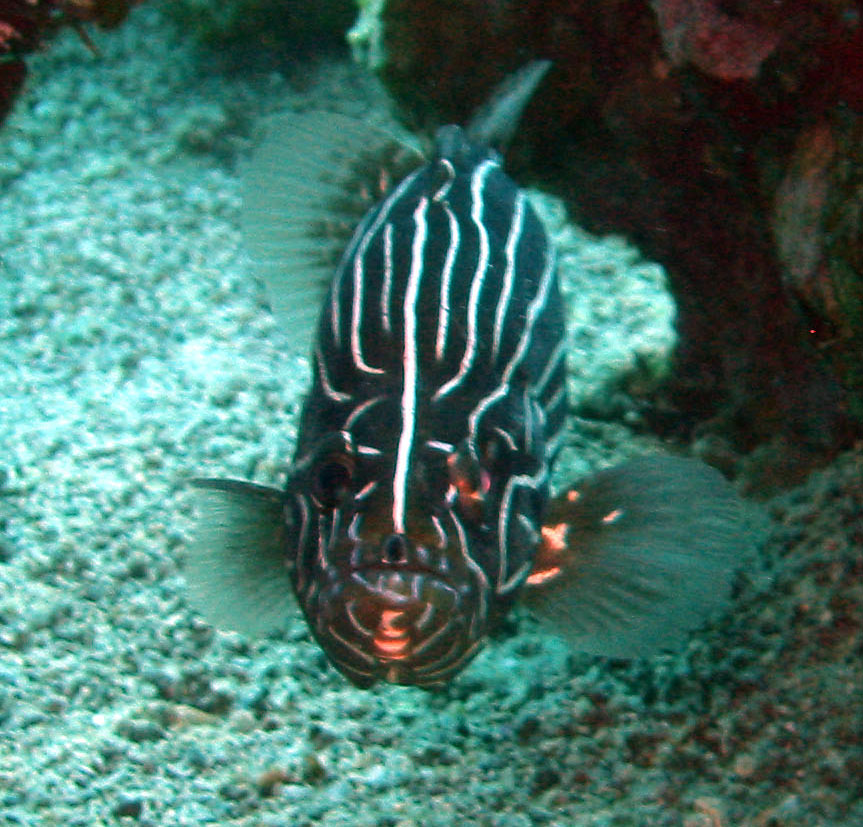Serranidae on:
[Wikipedia]
[Google]
[Amazon]
The Serranidae are a large


 In recent times, this family has been proposed to be split. The two hypothetical families emerging from the remains of the possibly-obsolete taxon are the families Epinephilidae and Anthiadidae. This taxonomic separation is recognized by some authorities, including the IUCN.
Recent molecular classifications challenge the validity of the genera '' Cromileptes'' (sometimes spelled '' Chromileptes'') and '' Anyperodon''. Each of these two genera has a single species, which were included in the same clade as species of '' Epinephelus'' in a study based on five different genes.
The subfamilies and genera are as follows:
In recent times, this family has been proposed to be split. The two hypothetical families emerging from the remains of the possibly-obsolete taxon are the families Epinephilidae and Anthiadidae. This taxonomic separation is recognized by some authorities, including the IUCN.
Recent molecular classifications challenge the validity of the genera '' Cromileptes'' (sometimes spelled '' Chromileptes'') and '' Anyperodon''. Each of these two genera has a single species, which were included in the same clade as species of '' Epinephelus'' in a study based on five different genes.
The subfamilies and genera are as follows:
family
Family (from la, familia) is a group of people related either by consanguinity (by recognized birth) or affinity (by marriage or other relationship). The purpose of the family is to maintain the well-being of its members and of society. Idea ...
of fish
Fish are aquatic, craniate, gill-bearing animals that lack limbs with digits. Included in this definition are the living hagfish, lampreys, and cartilaginous and bony fish as well as various extinct related groups. Approximately 95% of ...
es belonging to the order Perciformes
Perciformes (), also called the Percomorpha or Acanthopteri, is an order or superorder of ray-finned fish. If considered a single order, they are the most numerous order of vertebrates, containing about 41% of all bony fish. Perciformes means ...
. The family contains about 450 species in 65 genera, including the sea basses and the groupers (subfamily Epinephelinae). Although many species are small, in some cases less than , the giant grouper (''Epinephelus lanceolatus'') is one of the largest bony fishes in the world, growing to in length and in weight. Representatives of this group live in tropical and subtropical seas worldwide.
Characteristics
Many serranid species are brightly colored, and many of the larger species are caught commercially for food. They are usually found overreef
A reef is a ridge or shoal of rock, coral or similar relatively stable material, lying beneath the surface of a natural body of water. Many reefs result from natural, abiotic processes— deposition of sand, wave erosion planing down rock o ...
s, in tropical
The tropics are the regions of Earth surrounding the Equator. They are defined in latitude by the Tropic of Cancer in the Northern Hemisphere at N and the Tropic of Capricorn in
the Southern Hemisphere at S. The tropics are also referred to ...
to subtropical waters along the coasts. Serranids are generally robust in form, with large mouths and small spines on the gill coverings. They typically have several rows of sharp teeth, usually with a pair of particularly large, canine-like teeth projecting from the lower jaw.
All serranids are carnivorous. Although some species, especially in the Anthiadinae subfamily, only feed on zooplankton
Zooplankton are the animal component of the planktonic community ("zoo" comes from the Greek word for ''animal''). Plankton are aquatic organisms that are unable to swim effectively against currents, and consequently drift or are carried along by ...
, the majority feed on fish and crustaceans. They are typically ambush predators, hiding in cover on the reef and darting out to grab passing prey. Their bright colours are most likely a form of disruptive camouflage, similar to the stripes of a tiger
The tiger (''Panthera tigris'') is the largest living cat species and a member of the genus ''Panthera''. It is most recognisable for its dark vertical stripes on orange fur with a white underside. An apex predator, it primarily preys on ...
.
Many species are protogynous
Sequential hermaphroditism (called dichogamy in botany) is a type of hermaphroditism that occurs in many fish, gastropods, and plants. Sequential hermaphroditism occurs when the individual changes its sex at some point in its life. In particular, ...
hermaphrodites, meaning they start out as females and change sex to male later in life. They produce large quantities of eggs and their larvae are planktonic, generally at the mercy of ocean currents until they are ready to settle into adult populations.
Like other fish, serranids harbour parasite
Parasitism is a close relationship between species, where one organism, the parasite, lives on or inside another organism, the host, causing it some harm, and is adapted structurally to this way of life. The entomologist E. O. Wilson has ...
s, including nematodes, cestodes, digeneans, monogenea
Monogeneans are a group of ectoparasitic flatworms commonly found on the skin, gills, or fins of fish. They have a direct lifecycle and do not require an intermediate host. Adults are hermaphrodites, meaning they have both male and female repro ...
ns, isopods, and copepods. A study conducted in New Caledonia has shown that coral reef
A coral reef is an underwater ecosystem characterized by reef-building corals. Reefs are formed of colonies of coral polyps held together by calcium carbonate. Most coral reefs are built from stony corals, whose polyps cluster in groups.
C ...
-associated serranids harbour about 10 species of parasites per fish species.
Classification


Notes
References
* * {{Authority control Marine fish families Taxa named by William John Swainson